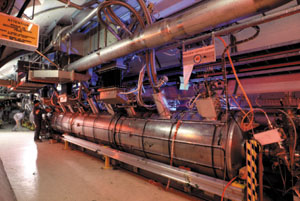
With possible signs of the elusive Higgs particle on the horizon, on 14 September CERN decided to
extend the life of its flagship LEP electron-positron collider until 2 November 2000.
LEP’s 11 year period of physics research was scheduled to finish at the end of September, to allow commencement of serious engineering for the installation of CERN’s new Large Hadron Collider (LHC). However, the new Higgs hints from the LEP experiments justify this change of plan. The construction schedule for LHC – expected to begin operations in 2005 – will not be affected by the prolonged LEP operation.
One of LEP’s main physics aims has always been to search for the missing link of the Standard Model of particle physics – the Higgs particle, which breaks electroweak symmetry. The Higgs field pervades the whole of space and endows particles with mass.
During LEP’s first phase of operations from 1989 until 1995, the collision energy was set at just over 91 GeV (the mass of the Z particle, the neutral carrier of the weak force), and searches showed that the Higgs must be heavier than 65 GeV. From 1996, Higgs searches at LEP continued as successive collision energy increases reached 202 GeV in 1999, showing that the Higgs must be heavier than 108 GeV.
In April the stage was set for a final push. Everything was done to boost the energy of LEP’s particle beams as high as possible. Excellent work by CERN teams has allowed LEP to achieve collision energies of up to 209 GeV, well beyond the original design energy.
As experimental data started to accumulate above 206 GeV, a number of events compatible with a Higgs production with mass around 114-115 GeV were reported in the combined results of the four LEP experiments, ALEPH, DELPHI, L3 and OPAL. In these events, a LEP electron-positron pair could produce a back-to-back Z and Higgs particle. However, these signals are difficult to disentangle from more common processes, notably the production of Z and W particle pairs.
The prolongation of the LEP running in October 2000 is the response to this intriguing situation. The extension, the maximum still compatible with the tight LHC construction schedule, should effectively double the experimental data at collision energies above 206 GeV, allowing the candidate Higgs signal at 114 GeV to be tested. Such light Higgs particles would be copiously produced at the LHC.
The decision to extend LEP’s experimental programme set the scene for a cliffhanger finish to its career. Many eyes are scrutinizing the latest data.
On 9-11 October, a series of major events at CERN marked the imminent end of the LEP era. Reports of these events will feature in the next issue.





